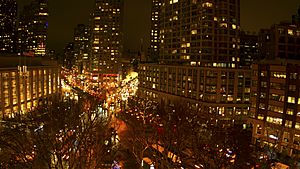Lincoln Square, Manhattan facts for kids
Lincoln Square is the name of both a square and the surrounding neighborhood on the Upper West Side of Manhattan in New York City. Lincoln Square is centered on the intersection of Broadway and Columbus Avenue, between West 65th and 66th streets. The neighborhood is bounded by Columbus and Amsterdam avenues to the east and west, and 66th and 63rd streets to the north and south, respectively. However, the term can be extended to refer to the neighborhood between 59th and 72nd streets. It is bounded by Hell's Kitchen, Riverside South, Central Park, and the Upper West Side proper. The Walt Disney Company’s New York City campus is located here, including ABC, ESPN, Hulu and studios for WABC-TV.
The area includes the 66th Street–Lincoln Center station served by the New York City Subway's 1 and 2 train, and is anchored by Lincoln Center, a collection of performing-arts venues, and the Manhattan campus of Fordham University.
Lincoln Square is part of Manhattan Community District 7 and its primary ZIP Code is 10023. It is patrolled by the 20th Precinct of the New York City Police Department.
History
Lincoln Square is located on the site of San Juan Hill, a predominantly African American neighborhood of tenements. San Juan Hill was generally bordered by Amsterdam Avenue to the east, West End Avenue to the west, 59th Street to the south, and 65th Street to the north. It has been suggested that the area was named after the 10th Cavalry that fought with Theodore Roosevelt at the Battle of San Juan Hill during the Spanish–American War, but this is not certain. It was possibly the most heavily populated African-American neighborhood in Manhattan in the early 20th century. One of the blocks within the neighborhood contained almost 5,000 residents.
Notable residents had included Thelonious Monk, who came to live here in 1922. In addition to the significant African American community, there was also an Afro-Caribbean community there, which has left its traces in the Bye-ya and Bemsha Swing compositions of Thelonious Monk, co-written much later with Denzil Best, who also grew up in this neighborhood. James P. Johnson also lived in the neighborhood in the 1910s and 1920s, during which time he composed the music for the "Charleston" dance.
In 1940, the New York City Housing Authority characterized the area as "the worst slum section in the City of New York" and made plans to renew the area by demolishing the old tenements. The Amsterdam Housing Projects were built on the cleared land in 1948, replacing three blocks that had collectively housed 1,100 residents.
During the 1950s and 1960s, a consortium of civic leaders and others led by John D. Rockefeller III built the Lincoln Center as part of the "Lincoln Square Renewal Project" during urban planner Robert Moses's program of urban renewals. Respected architects were contracted to design the major buildings on the site, and construction started in 1959. Over the next thirty years the previously blighted area around Lincoln Center became a new cultural hub. Over 7,700 residents were displaced during the redevelopment project. The new developments contained 4,400 housing units, of which only a few were allocated to San Juan Hill's former residents. Most of the area's former residents instead moved to Harlem, another predominantly African American neighborhood in Upper Manhattan, as well as the Bronx.
Name
Lincoln Center was named after Lincoln Square. The reason for naming the area "Lincoln Square" is unknown, however. The name was bestowed on the area in 1906 by the New York City Board of Aldermen, but records give no reason for choosing that name.
There has long been speculation that the name came from a local landowner, because the square was previously named Lincoln Square. City records from the time show only the names Johannes van Bruch, Thomas Hall, Stephan de Lancey, James de Lancey, James de Lancey Jr. and John Somerindyck as area property owners.
The area may also have been named as a tribute to U.S. President Abraham Lincoln. One speculation is that references to President Lincoln were omitted from the records because the mayor in 1906 was George B. McClellan Jr., son of General George B. McClellan who was general-in-chief of the Union Army during the American Civil War and a bitter rival of Lincoln.
Demographics
Based on data from the 2010 United States Census, the population of Lincoln Square was 61,489, an increase of 6,250 (11.3%) from the 55,239 counted in 2000. Covering an area of 371.00 acres (150.14 ha), the neighborhood had a population density of 165.7 inhabitants per acre (106,000/sq mi; 40,900/km2).
As of the 2010 Census, the racial makeup of the neighborhood was 73.4% (45,103) White, 4.4% (2,710) African American, 0.1% (58) Native American, 11.2% (6,916) Asian, 0.0% (14) Pacific Islander, 0.3% (175) from other races, and 1.9% (1,196) from two or more races. Hispanic or Latino of any race were 8.6% (5,317) of the population.
Points of interest
|
|
Notable residents
- Barbara Hillary (1931–2019), the first African-American woman to reach both the North Pole and South Pole, was born in San Juan Hill.




